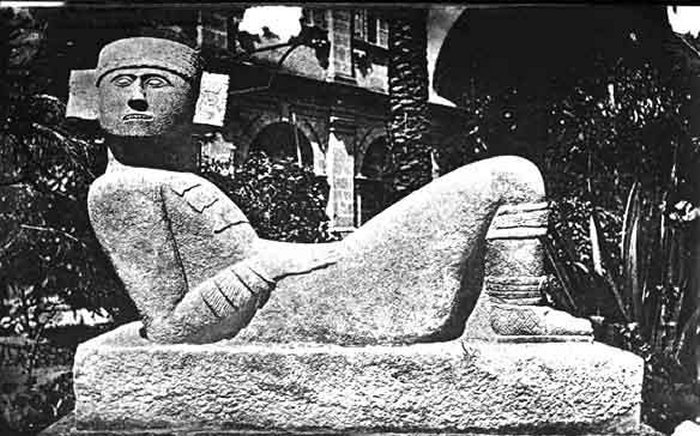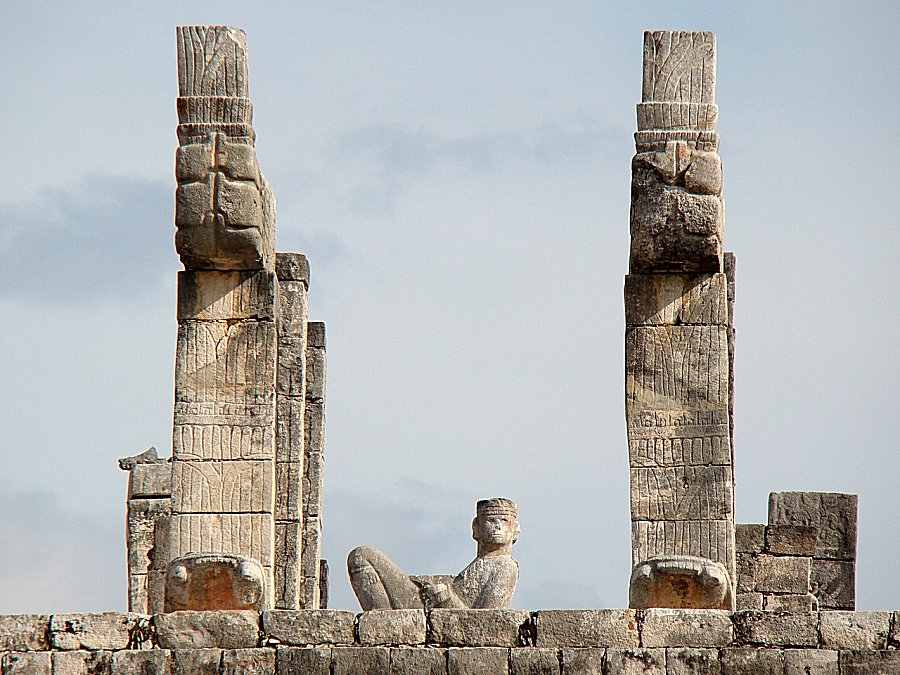Chacmool (‘Chac-Mool’) – Intriguing Pre-Columbian Statue Found At Many Ancient Sites In Mesoamerica
A. Sutherland - AncientPages.com - "Chac Mool" (chacmool, or chaacmol) is one of Mexico's most famous Pre-Columbian statues. Chac-Mool altars are generally found at the entrance to Toltec temples and other pre-Columbian cultural sites where Toltec influence was powerful, for example, Chichen Itza.
Chacmool excavated by Augustus Le Plongeon (d. 1908) from the Platform of the Eagles and Jaguars at Chichen Itza, Yucatan. 1875. Image uploader: Infrogmation - Public Domain
The great city of Chichén Itzá was the most important Mayan political, religious, and military Center in the north of Yucatán during its flourishing years, towards the end of the classic and the beginning of the Postclassic (800-1100 AD).
One such statue, for example, has been discovered in the Temple of Kukulkan (the Plumed Serpent), one of the most famous Maya pyramids - built at Chichén Itzá and later renamed El Castillo by the Spanish.
Archaeology confirms that twelve chacmools have been discovered at the Toltec city of Tula, known for its famous Atlantean Statues, the massive stone sculptures of warriors, the "Atlantes" that still hold a mystery: how the figures were carved and transported to the pyramid's top.
Usually, the sculpture is approximately human-sized and decorated with a headdress, bracelets, ear flares, and anklets. It depicts a resting man with his head directed to the left or the right but always facing 90 degrees from the front. The statue's posture is unique.
Curiously, this individual is always looking out away from the associated temple, supporting itself on its elbows and, at the same time, keeping a bowl (or disk) placed upon its torso. The bowl probably served as a holder for sacrificial blood and burnt offerings. It may also have had a symbolic meaning associated with the circular cenotes, which are deep sinkholes or holes particularly characteristic of Central America and Mexico and used during religious ceremonies (sacrifices) during the Mayan Empire.
What Is The Original Name Of The Statue?
As far as we know, Augustus Le Plongeon named "chac mool" after a mysterious statue he discovered during an archaeological expedition to Chichen Itza in 1873. However, the first published account of this kind of statue first appeared in 1832.
 Maya Chacmool from Chichen Itza displayed at the National Museum of Anthropology. Image credit: Ziko van Dijk - CC BY-SA 3.0
Maya Chacmool from Chichen Itza displayed at the National Museum of Anthropology. Image credit: Ziko van Dijk - CC BY-SA 3.0
Le Plongeon, a British-American archeologist and photographer, studied the pre-Columbian ruins of America and focused his research on the Maya civilization living on the northern Yucatán Peninsula. He discovered several important sites of Mayan culture and wrote several books later criticized by the scientific community as based on the author's flawed ideas.
According to Le Plongeon, the statue was supposed to represent an ancient Mayan king named "Chac-Mool" ("red Jaguar"), but the researcher was wrong, and historians have rejected his theory. According to the Maya, "chac-mool" means "the paw swift like thunder" (or "Thunderous Paw"), but the simple name "chac mool" has been widely adopted by researchers.
It's important that the statue's name, "Chac Mool," should not be confused with Chac, one of the foremost gods of Mayan mythology, who was initially related to rain, storms, and thunder. Aztec chacmools were associated with Tlaloc, the Mesoamerican rain god and the important deity in the Aztec pantheon.
Unknown Real Name, Identity And Function Of This Pre-Columbian Statue
The ancient name for these types of sculptures is unknown. It is also still being determined what or who the statue represents or its purpose.
Chuck-Mool. Statue at the top of the Temple of Warriors of the Chichen Itza complex. Credit: Bjørn Christian Tørrissen, One for the Road. CC BY-SA 3.0
What was the statue's original function? The Chaacmol does not appear to be of Maya origin. What mysterious ancient culture does he represent? Who were the male figures representing chacmools?
For over two centuries, "chacmool" has remained the subject of scientific speculations, and some possible explanations for this curious pre-Columbian figure are widely accepted.
As chackmools have never been discovered inside the temple's sanctuary or shrine, they have not been a subject of worship. Instead, they have been used by priests during their religious ceremonies. The statue could be a cuauhxicalli ("eagle gourd bowl") to receive blood and human hearts during sacrificial rituals prevalent among the Aztecs. The Aztecs used this bowl instead of the usual disc-altar. A chacmool from Tlaxcala. Mexico, for example, has a bloodied heart sculpted on the underside, supporting this interpretation.
It was also proposed that the bowl (or similar vessel) was used for collecting donations and gifts such as tobacco, turkeys, feathers, incense, tortillas, and pulque.
Or was Chac Mool perhaps a sacrificial stone over which victims were stretched so their hearts could be cut from their chests? In other words, "chacmools" were most probably related to the bloody ceremonies of the ancient Maya people.
Enigmatic monumental sculptures of "chacmool" were still in use when the Spanish contact in Central Mexico in the Aztec capital, Tenochtitlan, in the region of Chichen Itza) far as in El Salvador. In other Maya areas, researchers found fewer of these statues.
Updated on Nov 26, 2023
Written by – A. Sutherland - AncientPages.com Senior Staff Writer
Copyright © AncientPages.com All rights reserved. This material may not be published, broadcast, rewritten or redistributed in whole or part without the express written permission of AncientPages.com
Expand for referencesReferences:
Salisbury S. and Le Plongeon, A. The Mayas, the Sources of Their History Dr. Le Plongeon in Yucatan, His Account of Discoveries
More From Ancient Pages
-
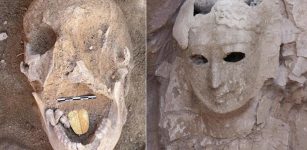 Ancient Egyptian Mummies With Golden Tongues Discovered In Alexandria
Archaeology | Feb 3, 2021
Ancient Egyptian Mummies With Golden Tongues Discovered In Alexandria
Archaeology | Feb 3, 2021 -
 Spectacular Square-Headed Creature And 143 New Nazca Geoglyphs – Discovered
Archaeology | Nov 19, 2019
Spectacular Square-Headed Creature And 143 New Nazca Geoglyphs – Discovered
Archaeology | Nov 19, 2019 -
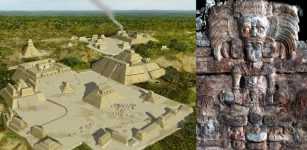 Mysterious Maya Snake Kings And Their Powerful Kingdom In The Jungle Reveal More Ancient Secrets
Civilizations | Apr 23, 2018
Mysterious Maya Snake Kings And Their Powerful Kingdom In The Jungle Reveal More Ancient Secrets
Civilizations | Apr 23, 2018 -
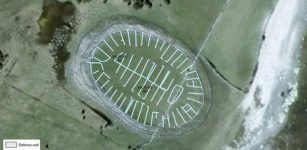 1500-Year-Old Mystery Of The Sandby Borg – Excavation Of Ringfort On Öland, Sweden
News | Jan 1, 2014
1500-Year-Old Mystery Of The Sandby Borg – Excavation Of Ringfort On Öland, Sweden
News | Jan 1, 2014 -
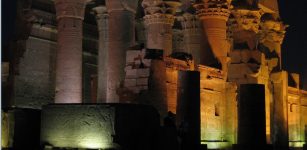 Two Discoveries Reported From Komombo Temple And Elephantine Island, Aswan
Archaeology | Dec 9, 2017
Two Discoveries Reported From Komombo Temple And Elephantine Island, Aswan
Archaeology | Dec 9, 2017 -
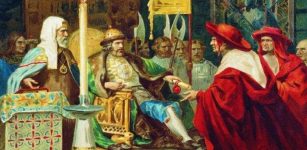 Alexander Nevsky: Grand Prince Of Novgorod, Skilled Fighter, Quick–Thinking Strategist Who Defeated Swedish And German Invaders
Featured Stories | Feb 22, 2019
Alexander Nevsky: Grand Prince Of Novgorod, Skilled Fighter, Quick–Thinking Strategist Who Defeated Swedish And German Invaders
Featured Stories | Feb 22, 2019 -
 Did An Ancient Supernova Force Humans To Walk Upright?
Human Beginnings | Oct 24, 2019
Did An Ancient Supernova Force Humans To Walk Upright?
Human Beginnings | Oct 24, 2019 -
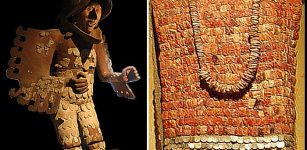 Fearsome Aztec Eagle And Jaguar Warriors Of Mesoamerica
Featured Stories | Sep 14, 2023
Fearsome Aztec Eagle And Jaguar Warriors Of Mesoamerica
Featured Stories | Sep 14, 2023 -
 Selinunte: Latest Excavations Bring To Light A New Small Temple – What Ritualistic Practices Will Be Revealed One Day?
Archaeology | Aug 12, 2024
Selinunte: Latest Excavations Bring To Light A New Small Temple – What Ritualistic Practices Will Be Revealed One Day?
Archaeology | Aug 12, 2024 -
 Ancient High-Technology: Automatons In Greek Mythology
Ancient Technology | Feb 22, 2015
Ancient High-Technology: Automatons In Greek Mythology
Ancient Technology | Feb 22, 2015 -
 Underground Hellenistic Necropolis With Tombs With Frescoes, Reliefs Unearthed In Naples, Italy
Archaeology | May 13, 2023
Underground Hellenistic Necropolis With Tombs With Frescoes, Reliefs Unearthed In Naples, Italy
Archaeology | May 13, 2023 -
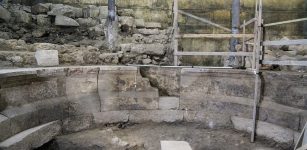 Roman Theater Unearthed After 1,700 Years Near Western Wall In Jerusalem
Archaeology | Oct 19, 2017
Roman Theater Unearthed After 1,700 Years Near Western Wall In Jerusalem
Archaeology | Oct 19, 2017 -
 Lost Maya City Hidden In The Volcanic Lake Atitlán Explored By Underwater Archaeologists
Archaeology | May 4, 2022
Lost Maya City Hidden In The Volcanic Lake Atitlán Explored By Underwater Archaeologists
Archaeology | May 4, 2022 -
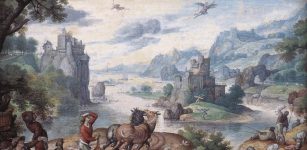 The Ancient ‘Flying Machines’ Of Icarus and Daedalus
Featured Stories | Aug 16, 2014
The Ancient ‘Flying Machines’ Of Icarus and Daedalus
Featured Stories | Aug 16, 2014 -
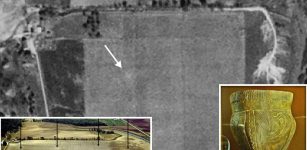 Long-Lost Ancient Burial Mounds Of The Havana Hopewell Culture Re-Discovered In Iowa
Archaeology | Apr 6, 2021
Long-Lost Ancient Burial Mounds Of The Havana Hopewell Culture Re-Discovered In Iowa
Archaeology | Apr 6, 2021 -
 Blackfoot People Carry DNA From Unknown Ancestors Who Came To America 18,000 Years Ago
DNA | Apr 4, 2024
Blackfoot People Carry DNA From Unknown Ancestors Who Came To America 18,000 Years Ago
DNA | Apr 4, 2024 -
 Legend Of Gyanganj – Antediluvian City Of Immortal Sages That Can Only Be Found By The Chosen Ones
Featured Stories | Jul 29, 2017
Legend Of Gyanganj – Antediluvian City Of Immortal Sages That Can Only Be Found By The Chosen Ones
Featured Stories | Jul 29, 2017 -
 On This Day In History: Mathematician And Astronomer Christiaan Huygens Born – On Apr 14, 1629
News | Apr 14, 2017
On This Day In History: Mathematician And Astronomer Christiaan Huygens Born – On Apr 14, 1629
News | Apr 14, 2017 -
 Strange Underwater Mini-Pyramid Older Than Stonehenge With Unknown Purpose – Who Built It?
Ancient Mysteries | Sep 12, 2021
Strange Underwater Mini-Pyramid Older Than Stonehenge With Unknown Purpose – Who Built It?
Ancient Mysteries | Sep 12, 2021 -
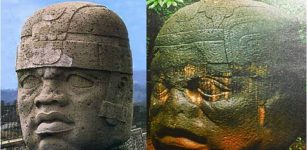 The Olmecs – Who They Were, Where They Came From Still Remains A Mystery
Civilizations | Feb 19, 2015
The Olmecs – Who They Were, Where They Came From Still Remains A Mystery
Civilizations | Feb 19, 2015

